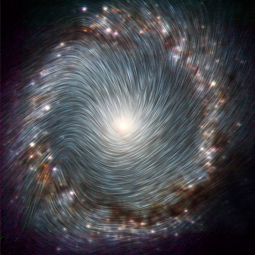By Enrique Lopez-Rodriguez and Joan Schmelz
Paper:
Extragalactic Magnetism with SOFIA (Legacy Program) - II: A Magnetically Driven Flow in the Starburst Ring of NGC 1097
Lopez-Rodriguez, Enrique, et al., 2021/12, ApJ, 923, 150.
Magnetically-driven flows feed the super massive blackhole at the center of NGC 1097. SOFIA investigated this long-standing problem of the large-scale transfer of matter from the body of the host galaxy to the active nucleus.
Observations indicate that around two-thirds of spiral galaxies have bars that may affect the transfer of matter. The bar creates non-circular motions, increasing particle collisions that dissipate energy and cause the gas to lose angular momentum and move inward. This moving gas may trigger a starburst ring and eventually feed the active nucleus. However, hydrodynamics models using this gravitational-potential scenario have difficulty reproducing the observed gas inflows.
Magnetohydrodynamic models can provide an alternative solution. Galactic bars and nuclear rings have strong magnetic fields, where the magnetic forces dominate the gas flows in the spiral and bar structures. The non-circular motions in bars interact with magnetic fields, and the magnetic stress removes angular momentum from the gas. The dominant magnetic fields then deflect the gas flow from the galactic bar to a new orbit, producing a central ring and/or central spiral towards the nucleus. The gas can then flow towards the active nucleus, which ultimately feeds the super massive black hole. However, the magnetic flows in the central region of galaxies have not been characterized until now.
NGC 1097 is a barred spiral galaxy with a starburst ring surrounding an active galactic nucleus. Herschel observed the total thermal emission arising from the starburst ring. Although these observations were able to characterize the efficiency of the star formation, there was no clear evidence of flowing material towards the galactic center. Radio polarimetric observations have shown that NGC 1097 has the strongest magnetic field strength of any observed spiral galaxy. This magnetic field dominates the transfer of gas from the spiral to the starburst ring, but the magnetic field in the central region of NGC 1097 had not been fully studied.
SOFIA measured the magnetic fields in the starburst ring with the High-resolution Airborne Wideband Camera-plus (HAWC+) at 89 microns with an angular resolution of 7.8” (~720 pc). These observations in combination with the radio polarimetric observations have been able to trace the magnetic fields in the multi-phase interstellar medium in the starburst ring of NGC 1097. SOFIA traces the magnetic fields in the dense and warm interstellar medium, while radio polarimetric observations trace the magnetic fields in the diffuse and hot interstellar medium.
To investigate this problem, researchers used linear polarization decomposition, a new technique developed to analyze the Event Horizon Telescope observations of the magnetic fields surrounding the super massive blackhole of Messier 87. The decomposition of NGC 1097 data shows that the magnetic field has multiple components. The analysis reveals a constant magnetic field morphology in the dense interstellar medium located at the contact points of the galactic bar and the starburst ring as well as a spiral-like magnetic field morphology in the diffuse interstellar medium around and within the starburst ring. These results show, for the first time, the non-circular behavior of the magnetic fields in the multi-phase interstellar medium.
In addition, this work combined information on the gas flows and estimated the direction of the magnetic field using rotation measures. Analysis indicates that the spiral magnetic field is the signature of a galactic dynamo action outside and inside the starburst ring. This magnetic field coupled to the diffuse interstellar medium may be dragging material from the host galaxy to the center region. At the same time, the magnetic field in the dense interstellar medium is compressed with a constant orientation at the contact regions feeding the starburst ring.
This work shows that the magnetic fields control the transfer of matter from the starburst ring towards the active galactic nucleus and played a fundamental role in the evolution of NGC 1097. The SOFIA Legacy Program on Extragalactic Magnetism will provide a larger sample of galaxies to test whether these results are general or applicable only to the galaxies with the strongest magnetic field.
